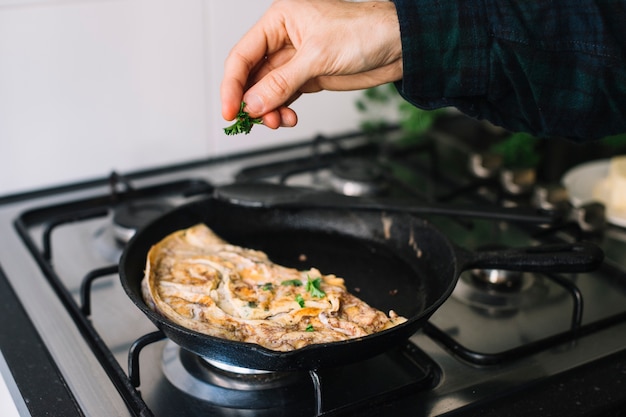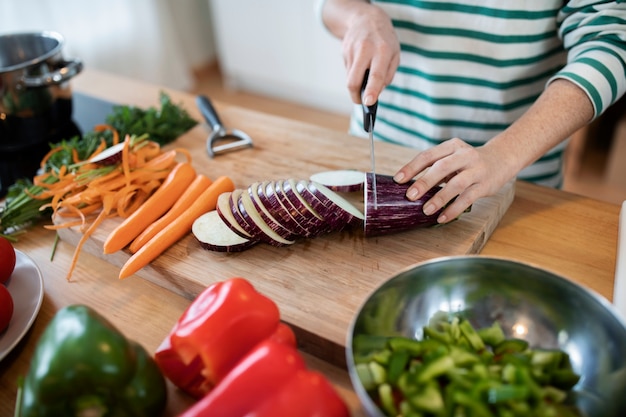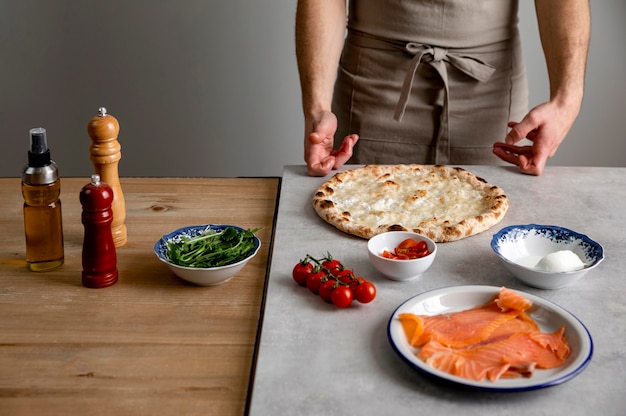Let's face it, there's nothing quite like a perfectly cooked ny strip steak. That beautiful sear, the melt-in-your-mouth tenderness, the juicy flavour... it's a culinary masterpiece! But for many, the thought of cooking a steak can be intimidating. You've got the whole searing, flipping, and resting thing, and you don't want to end up with something tough and dry, right? Well, fear not! I'm here to break down the process and show you how to achieve that perfect stovetop NY strip steak, every single time. Trust me, it's easier than you think, and you'll feel like a pro in the kitchen!
(Part 1) Choosing Your Steak: The Foundation of a Delicious Dinner

Alright, let's start at the beginning. You can't expect a perfect steak from a subpar piece of meat, so choosing the right one is crucial. Think of it as laying the foundation for a beautiful house. You want to go for a good quality, thick-cut NY strip steak, around 1 to 1.5 inches thick. That's about the right size for a nice, even cook.
What to Look For: Spotting a Quality Steak
Now, here's the fun part - learning how to pick out a winner at the butcher counter. Look for these qualities in your steak:
- Marbling: This is the key to a juicy, flavorful steak. Imagine it like sprinkles on a cake! You want to see good marbling, which is the fat distributed throughout the meat. Look for a nice white, even spread of fat. This fat will melt and render during cooking, adding flavour and moisture to your steak.
- Colour: A good steak will have a deep, rich red colour. Avoid any steaks that are dull, grey, or have any green or brown spots. That's a sign it's not fresh and might not be the best choice.
- Texture: Don't be afraid to get your hands dirty! Feel the steak. It should be firm and springy to the touch. Avoid anything that feels soft or mushy. That's a sign it might be past its prime and won't cook up as well.
Things to Consider: Making the Right Choice
Here are a few additional factors to consider when choosing your steak:
- Thickness: I'm a fan of a thicker cut, about 1.5 inches. It allows for a more even cook and results in a juicier steak. But if you prefer a thinner cut, make sure it's not too thin, otherwise it'll dry out easily.
- Weight: This depends on how many people you're feeding. A 1-inch thick steak will usually weigh about 10 ounces. So, if you're cooking for two, you'd probably want two steaks. For one person, you might want to get a slightly smaller piece, or just leave some leftovers for another delicious meal!
- Bone-in vs. Boneless: You can get bone-in or boneless NY strip steaks. Both are great, but bone-in will add a little extra flavour. It also tends to cook a bit more evenly, but you might need a larger pan to accommodate it.
(Part 2) Preparing Your Steak: Setting the Stage for Success

Now, you've got your beautiful steak, it's time to get it ready for cooking. This is a crucial step, so don't rush it! It's about giving your steak the best chance of being juicy and flavourful. Imagine it like prepping your garden before planting your seeds - you want to make sure the soil is fertile and ready to grow delicious produce.
Pat it Dry: The Importance of Moisture Control
Start by patting the steak dry with paper towels. Any excess moisture will steam the steak when you sear it, resulting in a less crispy crust. Remember, we want that beautiful sear! Think of it like getting rid of excess water before you bake a cake, to ensure a crispy crust and a fluffy interior.
Seasoning: Unlocking the Flavour
Now comes the fun part: seasoning! Salt and pepper are the classic staples, and trust me, they're all you really need. I like to season generously on both sides, then press the salt and pepper into the meat. It helps to bring out the natural flavours of the steak. Think of it like adding a pinch of spice to a plain dish - it enhances the overall taste and makes it more exciting.
Let it Rest: Achieving a Balanced Cook
Here's a tip that really makes a difference: let your steak come to room temperature before you cook it. This takes about 30 minutes. Why? Because it allows the internal temperature of the steak to even out, which means it will cook more evenly. It also helps to reduce the chances of overcooking the exterior while the center is still cold. Imagine it like letting your dough rise before baking bread - it ensures a more consistent texture and prevents uneven cooking.
Optional Extras: Adding a Touch of Personal Flair
Want to take your steak to the next level? You can add some extras to your seasoning. Think of it like adding a dash of creativity to your culinary masterpiece. Some options include:
- Garlic powder: Adds a delicious aroma and a hint of flavour.
- Onion powder: Adds a touch of sweetness and depth to the flavour.
- Dried herbs: Rosemary, thyme, or oregano can add a lovely, earthy flavour.
- Paprika: Adds a hint of smokiness and a vibrant colour.
(Part 3) The Tools You Need: Your culinary arsenal

Now, you've got your steak prepped, let's talk about the tools you need to get the job done. Don't worry, you don't need a whole kitchen arsenal. Just a few key items will do the trick. Think of them as your trusty companions on this culinary adventure.
- Heavy-bottomed pan: This is essential for even heat distribution. Look for a cast iron pan, or a heavy-duty stainless steel pan. If you're worried about scratching your pan, you can always use a nonstick pan, but it might not give you that beautiful sear you're looking for. It's like having a sturdy foundation for your house - it ensures stability and even cooking.
- Tongs: Use these to flip your steak and to move it around the pan. Make sure they're long enough to avoid getting your hand too close to the heat. Think of them as your trusty helpers, ensuring you can handle the hot steak with ease and precision.
- meat thermometer: This is a must-have for ensuring your steak is cooked to your preferred level of doneness. You don't want to be left guessing! Imagine it like a guide map on your culinary journey, ensuring you arrive at your desired destination.
- Cutting board: This is for slicing and serving your steak. Think of it as your finishing touch, a platform to showcase your culinary masterpiece.
(Part 4) The Cooking Process: Creating a Culinary Symphony
Alright, here we go! This is the moment you've been waiting for - the actual cooking of the steak. Don't worry, I'll walk you through it step by step, so you can achieve that perfect sear and juicy interior.
Heating the Pan: Setting the Stage
The first step is to heat your pan. Get it nice and hot, over medium-high heat. You want it to be hot enough to create a beautiful, crispy sear, but not so hot that the steak burns. Here's a little trick: add a tablespoon of oil to the pan and heat it up for a minute. Then, drop a few drops of water into the pan. If the water sizzles and evaporates quickly, you're good to go. Imagine it like preheating your oven for baking - it ensures a consistent cooking environment and a delicious final product.
Searing: Building the Foundation
Now, carefully place your steak in the pan. Don't crowd the pan, give it enough space to breathe. This is where the magic happens. Let the steak sear undisturbed for 3-4 minutes per side, or until you have a nice, crispy crust. Don't keep flipping it over and over, that will just make the steak tough. Let the steak cook undisturbed, so it develops that nice, crispy crust. You'll see a beautiful golden brown colour. Think of this step as laying the foundation of your steak - a strong, crispy crust that locks in flavour and moisture.
Lowering the Heat: Creating Harmony
After you've seared both sides, lower the heat to medium-low. You want the steak to cook through without overcooking the exterior. This will take about 4-6 minutes per side, depending on how thick your steak is and how well done you want it. This is where your meat thermometer comes in handy. It will tell you when your steak is cooked to your liking. Imagine this step as adding harmony to your culinary symphony - ensuring all parts of the steak are cooked to perfection, creating a balanced flavour profile.
Resting: Allowing the Flavour to Bloom
The final step is the resting process. This is just as important as the cooking process, as it allows the juices to redistribute throughout the steak. Transfer the steak to a cutting board and let it rest for 5-10 minutes before slicing and serving. Think of this step like letting your cake cool before frosting - it allows the moisture to settle and the flavour to bloom, resulting in a more enjoyable experience.
(Part 5) Checking for Doneness: Navigating the Culinary Landscape
How do you know when your steak is cooked to your liking? Well, there are a few methods you can use. Think of them as your guideposts on this culinary journey, helping you arrive at your desired destination.
The Finger Test: A Visual Guide
This is a good visual guide, but it's not as accurate as a meat thermometer. Think of it like a rough map - it gives you a general idea, but it might not be completely accurate.
| Doneness | Feel |
|---|---|
| Rare | Soft and slightly yielding |
| Medium-rare | Firm but still slightly yielding |
| Medium | Firm and springy |
| Medium-well | Firm and very springy |
| Well-done | Very firm and almost hard |
The Meat Thermometer: A Precise Compass
This is the most accurate method for determining doneness. Just insert the thermometer into the thickest part of the steak, making sure it doesn't touch any bone. Here are the recommended internal temperatures:
| Doneness | Internal Temperature (°F) | Internal Temperature (°C) |
|---|---|---|
| Rare | 125-130 | 52-54 |
| Medium-rare | 130-135 | 54-57 |
| Medium | 135-140 | 57-60 |
| Medium-well | 140-145 | 60-63 |
| Well-done | 145-150 | 63-66 |
(Part 6) Serving Your Steak: A Culinary Celebration
Now you've cooked your steak to perfection, it's time to enjoy the fruits of your labour. There are endless possibilities when it comes to serving your steak, but here are some of my favourites. Think of this as the grand finale of your culinary journey, a moment to savour and enjoy the delicious results.
Simple and Classic: A Timeless Combination
You can't go wrong with a classic pairing: a juicy steak with some crispy fries, a green salad, and a generous knob of butter.
Elevating the Flavour: A Touch of Sophistication
For something a bit more decadent, try a creamy mushroom sauce or a rich red wine sauce. A simple pan sauce made with the drippings from your steak is also delicious. Imagine this as adding a touch of elegance to your masterpiece, enhancing the flavour profile and creating a truly memorable dining experience.
Adding a Bit of Heat: A Spicy Twist
If you like things spicy, add a dollop of horseradish or some fiery chili sauce. Think of it as adding a dash of excitement to your culinary adventure, a burst of flavour that awakens the senses.
(Part 7) Making a Pan Sauce: Turning Drippings into Deliciousness
If you want to make a simple and delicious pan sauce, here's how: Think of it as transforming the essence of your steak into a flavorful companion.
- Deglaze the pan: After removing the steak, pour in a tablespoon of red wine or broth into the pan. Scrape the bottom of the pan to loosen any browned bits. This will give your sauce a rich flavour. Imagine this as extracting the hidden flavours from the pan, transforming them into a delicious sauce.
- Add butter and herbs: Add a tablespoon of butter and a sprig of fresh thyme or rosemary. Swirl the pan until the butter melts and the herbs release their flavour. Think of this as adding a touch of finesse, enhancing the flavour and aroma of the sauce.
- Season to taste: Season the sauce with salt and pepper. You can also add a squeeze of lemon juice for a touch of acidity. Imagine this as fine-tuning the flavour profile, ensuring the sauce complements your steak perfectly.
- Serve: Pour the sauce over the steak and enjoy!
(Part 8) Storing Leftovers: Extending the Culinary Delight
If you've got any leftover steak, store it in an airtight container in the fridge for up to 3-4 days. You can reheat it in the oven or microwave. But, let's be honest, the best way to enjoy leftover steak is in a delicious sandwich or salad. Imagine it as turning your culinary masterpiece into a delightful new creation, full of flavour and potential.
FAQs: Addressing Your Culinary Concerns
Got some burning questions? Here are some answers to the most common questions about cooking a perfect steak.
Q: How do I make sure my steak is cooked evenly?
A: The key is to start with a steak of even thickness. Also, ensure your pan is hot enough to create a good sear, but not so hot that it burns the steak. Flip the steak only once it has developed a nice crust on one side. Use a meat thermometer to check for doneness, and let it rest before slicing. Think of it like a well-planned journey - careful preparation, consistent heat, and a watchful eye ensure a smooth and successful culinary adventure.
Q: What can I do if my steak is overcooked?
A: Unfortunately, there's not much you can do to reverse overcooking. But, you can try to salvage it by slicing it thinly and adding it to a sandwich, salad, or stir-fry. Think of it as adapting your plans - even if things don't go perfectly, you can still create something delicious and satisfying.
Q: What is the best way to clean a cast iron pan?
A: The best way to clean a cast iron pan is with hot water and a scrub brush. Don't use soap, as it can strip the seasoning off the pan. After cleaning, dry the pan thoroughly and rub a thin layer of oil onto the surface. This will help to maintain the seasoning and prevent rust. Think of it like caring for your treasured tools - proper cleaning and maintenance ensure they last a lifetime.
Q: Can I cook a steak in a nonstick pan?
A: Yes, you can, but you might not get that beautiful, crispy sear that you get with a cast iron or stainless steel pan. Nonstick pans can work well for thinner steaks or for cooking quickly over high heat. Think of it as choosing the right tool for the job - sometimes a more delicate approach is needed.
Q: What are some good wine pairings for steak?
A: A good rule of thumb is to pair a red wine with a steak. Cabernet Sauvignon, Merlot, and Syrah are all excellent choices. If you're looking for something lighter, Pinot Noir or Zinfandel can also be good pairings. Think of it as creating a harmonious balance - the wine should complement the steak, enhancing the overall flavour experience.
Everyone is watching

Prime Rib Roast Cooking Time Chart: Per Pound Guide
Cooking TipsPrime rib roast. Just the name conjures images of lavish dinners, crackling fires, and hearty laughter. It’s ...

How Long to Bake Potatoes in the Oven (Perfect Every Time)
Cooking TipsBaked potatoes are a staple in my kitchen. They're incredibly versatile, delicious, and surprisingly easy to m...

Perfect Rice Every Time: The Ultimate Guide to Cooking Rice
Cooking TipsAs a self-proclaimed foodie, I've always been a bit obsessed with rice. It's the foundation of countless cuisi...

The Ultimate Guide to Cooking Asparagus: Tips, Techniques, and Recipes
Cooking TipsAsparagus. The mere mention of this spring delicacy conjures up images of vibrant green spears, crisp and burs...

Ultimate Guide to Cooking the Perfect Thanksgiving Turkey
Cooking TipsThanksgiving. Just the word conjures up images of overflowing tables laden with delicious food, the scent of r...
